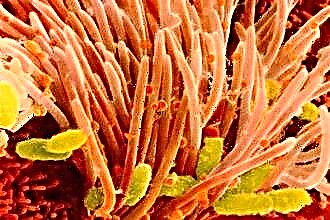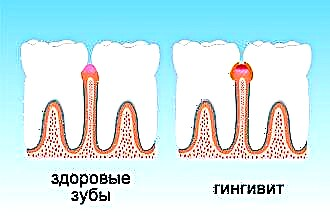Inflammation of the larynx, which is characterized by respiratory failure and damage to the voice-forming apparatus, is called laryngitis. Symptoms of the development of the disease are: barking cough, inspiratory shortness of breath (difficulty breathing), high fever, hoarseness, rapid breathing, and discomfort in the throat.
 What are the reasons for laryngitis in children? It almost never occurs as an independent disease. Inflammation of the larynx is often preceded by tonsillitis, SARS, flu, bacterial rhinitis, rhinosinusitis, bronchitis, measles or scarlet fever. The disease is extremely dangerous for children, since against its background, a small patient may develop a false croup. Severe swelling of the mucous membranes leads to a decrease in the lumen in the larynx. This, in turn, becomes the cause of the development of respiratory failure, spastic cough and attacks of suffocation.
What are the reasons for laryngitis in children? It almost never occurs as an independent disease. Inflammation of the larynx is often preceded by tonsillitis, SARS, flu, bacterial rhinitis, rhinosinusitis, bronchitis, measles or scarlet fever. The disease is extremely dangerous for children, since against its background, a small patient may develop a false croup. Severe swelling of the mucous membranes leads to a decrease in the lumen in the larynx. This, in turn, becomes the cause of the development of respiratory failure, spastic cough and attacks of suffocation.
About the disease
Laryngitis in a child in 9 out of 10 cases develops against the background of respiratory diseases. Inflammation of the larynx and vocal cords leads to a decrease in timbre and hoarseness of the voice. If vocal rest is not observed and the vocal cords are overstrained, children often develop temporary aphonia, i.e. loss of sonority of the voice.
According to statistics, children of preschool age are more susceptible to laryngitis. Approximately 34% of young patients with ARVI are diagnosed with laryngitis, which can subsequently be complicated by bronchitis, tracheitis, pneumonia, etc. The disease is quite dangerous and can cause serious complications. Against the background of infectious and allergic reactions in the laryngeal mucosa in children, airway obstruction (obstruction) occurs.
With a critical narrowing of the respiratory tract, stenosing phenomena occur in the larynx, which are fraught with attacks of suffocation and death.
Inflammation of the larynx is associated with the penetration of pathogens or allergens into the respiratory tract. By penetrating into the laryngeal mucosa, they cause inflammation and swelling of soft tissues. In this regard, children develop symptoms of respiratory failure (shortness of breath, rapid breathing, blue lips) and intoxication of the body (lethargy, nausea, headaches, loss of appetite).
Why is laryngitis dangerous?
In pediatrics, children's laryngitis is regarded as one of the most dangerous respiratory diseases. This is largely due to the anatomical and physiological features of the structure of the respiratory tract in babies and the specific course of the disease. In preschool children, the larynx has the shape of a funnel, tapering downward. It is covered with a loose mucous membrane that is susceptible to infection with pathogenic viruses and bacteria.
It should be noted that in children, the immune defense is much weaker than in adults. This is due to insufficient development of adaptive (acquired) immunity. Breathing in polluted air that contains pathogens puts a child at risk of respiratory illness. With inflammation of the larynx, the soft tissues swell slightly, but if the thickness of the mucous membrane increases by at least 1 mm, the patency of the respiratory tract decreases by 50%.
Taking into account the specifics of the course of inflammatory processes in the larynx, laryngitis can be sluggish (chronic) or acute. According to many pediatricians, chronic laryngitis in children is the most dangerous form of the disease, as it causes pathological changes in the structure of the mucous membranes. In babies up to 2-3 years old, the so-called hypertrophic laryngitis is more often diagnosed, in which there is hyperplasia (proliferation) of the mucous membrane. A strong thickening of the walls of the larynx entails obstruction of the airways, which is fraught with attacks of suffocation, which occur mainly in the morning after waking up the child or at night.
Causative agents of the disease
What are the main causes of laryngitis in children? The onset of the disease is most often associated with exposure to allergic and infectious factors. Pathogens of laryngitis can be pathogenic microbes or viruses:
- adenoviruses;
- parainfluenza virus;
- wand Borde-Zhangu;
- PC viruses;
- rhinoviruses;

- coronaviruses;
- streptococci;
- pneumococci;
- meningococci.
Bacterial laryngitis causes severe intoxication of the child's body, therefore it is much more severe than a viral disease.
Infectious laryngitis occurs mainly in the cold season against the background of hypothermia and nasal breathing disorders. The development of the disease is facilitated by a decrease in immunity, which is associated with a lack of vegetables and fruits in the diet, rich in trace elements and vitamins. In addition, it is in the autumn-winter period that chronic diseases are exacerbated in children, which can provoke the development of respiratory disease.
Allergic inflammation of the larynx in young children is more often associated with the inhalation of polluted air, vapors of alkyd paints, household chemicals, pollen, etc. Irrational intake of drugs and vasoconstrictor nasal drops can contribute to the development of allergic reactions. Therefore, doctors do not recommend resorting to the use of medications for no apparent reason.
Why do children get sick?
As mentioned, laryngitis in children rarely develops in isolation. Typically, the larynx is involved in inflammatory processes that occur in the upper or lower respiratory tract. Very often, the disease is diagnosed against the background of such respiratory diseases as:
- flu;
- herpes simplex;
- whooping cough;
- scarlet fever;
- ARVI;
- tonsillitis;
- adenoiditis;
- chronic rhinitis;
- pharyngitis;
- bronchitis.
Sometimes damage to the laryngeal mucosa is observed against the background of the development of non-infectious pathologies. In particular, gastroesophageal reflux, which is quite common in infants, irritates the upper esophagus. Throwing enough caustic gastric juice into the respiratory tract causes damage to the larynx and, as a result, the development of laryngitis. In this case, young patients are diagnosed with a disease called reflux laryngitis.
Provoking factors
In babies under 2 years of age, the submucous layer of the larynx is very loose and therefore prone to inflammation and severe edema. A decrease in the size of the glottis makes it difficult for air to enter the lungs, as a result of which respiratory failure occurs. Oxygen deficiency negatively affects gas exchange in cells, which leads to the accumulation of carbon dioxide in tissues. It is for this reason that children literally turn blue, in particular lips and limbs.
To prevent the progression of the disease, it is necessary to definitely identify and eliminate the provoking factors that caused the inflammation of the larynx. The most common reasons contributing to the development of the disease include:
- hypothermia;

- second hand smoke;
- inhalation of dusty air;
- exacerbation of chronic diseases;
- overexertion of the voice (prolonged conversation, screaming);
- carious teeth and dental pathologies (periodontal disease, gingivitis, stomatitis).
The risk group includes children who suffer from lymphatic-hypoplastic diathesis and chronic diseases of the nasopharynx (sphenoiditis, sinusitis, ethmoiditis, adenoiditis).
Prevention measures
Primary prevention of laryngitis consists in maintaining personal hygiene, strengthening the immune system and regularly cleaning the room in which the child is. General guidelines for preventing disease include:
- protecting children from secondhand smoke;
- adequate load on the vocal apparatus;
- timely treatment of colds;
- overheating and hypothermia prevention;
- protection from contact with infected people.
Young children tend to "drag" their hands into their mouths, and it is on the hands that the largest number of potentially dangerous viruses and microbes are concentrated. To prevent infection from developing, wash your hands regularly with disinfectant soap. Outside the home, maintaining hygiene is more difficult, but still possible. In this case, a special alcohol-based hand spray or sanitary wet wipes will be the best helper.
Balanced diet
What can be the prevention of laryngitis in children? Prevention of inflammation of the larynx is the prevention of respiratory diseases. To reduce the likelihood of developing an infection in a child's body, you need to take care of strengthening the immune system. First of all, it is necessary to include in the diet foods that contain a large amount of vitamins C, E and B. It is they who take an active part in metabolic processes and increase the body's resistance to pathogenic agents.
It is recommended to include natural juices, dried fruit compotes, chamomile and thyme tea in the menu. Raspberry and currant jam will be no less effective, which can be given to children in the course of ARVI treatment. It should be noted that vitamin and mineral complexes can also be used as sources of vitamins missing in the body. The most suitable drugs for children include Alphabet, Complivit, Aevit, Pikovit and Jungle.
It must be remembered that preventive measures help prevent the development of not only respiratory diseases, but also serious complications. A balanced diet, adherence to the rules of personal hygiene, as well as regular cleaning of the premises can reduce the likelihood of developing colds by 30%.





